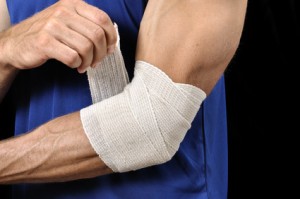It is a well-known fact that exercise is central to maximizing physical and mental wellness. Aside from promoting cardiovascular health, physical activity strengthens and enhances the functionality of bones, muscles and systems of the body. Through exercise, the body’s soft tissues break down and subsequently grow stronger than before in a delicately balanced cycle. However, if the breakdown occurs more rapidly than the rebuilding process, an injury will result.
There are basically two types of bodily injuries: acute (breaks, dislocations, or sprains) and overuse injuries. Overuse injuries result from repetitive motions and the resulting trauma. These injuries occur over a period of time and are often difficult to treat. Tennis and golfer’s elbow are two common types of overuse injuries. Technically called lateral or medial epicondylitis, respectively, these injuries affect the area where the muscles and tendons in the lower arm attach to the bone of the elbow either on the inside (for golfer’s elbow) or the outside (for tennis elbow).
Not Just For Athletes
While these injuries take their names from the multitudes of affected golf and tennis players, you don’t have to play those sports to develop the same conditions. Anyone who performs activities requiring repetitive motion of the elbow, wrist or hand can suffer from tennis or golfer’s elbow. Sports like bowling and baseball can be culprits as well as certain vocations like staffing an assembly line, construction, or landscaping work. Pain usually increases slowly around the elbow and worsens progressively. Eventually, everyday activities like opening jars, shaking hands and brushing teeth can become significantly painful.
Diagnoses and Traditional Treatment
Tennis and golfer’s elbow can be difficult to diagnose. The diagnosis usually occurs based on a thorough physical exam and questioning by the doctor and a patient’s description of the pain. Traditional treatments consist of the RICE regimen (rest, ice, compression, elevation), a schedule of NSAIDS (like ibuprofen or naproxen), corticosteroid injections, physical rehabilitation, and a modification of the activities or habits responsible for the injury (which are exacerbated by poor form).
Therapy Focused on Healing
Over the past several years, regenerative therapy has gained increased acceptance as a viable treatment option for overuse injuries of all types. (See also: our earlier article about regenerative therapy.) Regenerative therapy is different from traditional methods because it places an increased emphasis on the healing of the affected soft tissues, rather than simply a decrease in symptoms. Regenerative therapy involves the injection of Platelet Rich Plasma (PRP) directly into the injury site to jump-start and maximize the body’s natural healing process. The solution (of which there are several different kinds) causes the injured tissue to release specific growth factors, which in turn attract healing cells to the injury site.
The body of clinical research focusing on regenerative therapy as an effective means of treatment for musculoskeletal injuries has continued to grow. Patients have seen excellent results in many different areas of the body—because this protocol triggers the same healing response regardless of the specific location of the injury.
If you are experiencing pain that has not responded to traditional treatments like physical therapy, cortisone injections or even surgery, you may be a good candidate for regenerative therapy. Contact us today for a free consultation.






